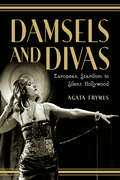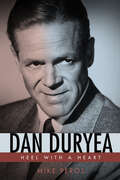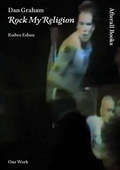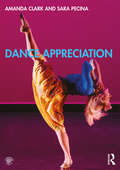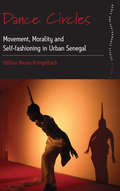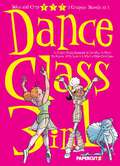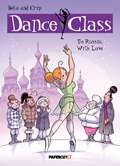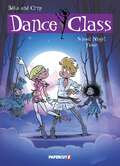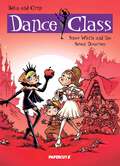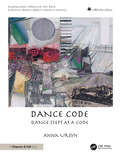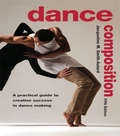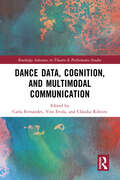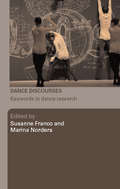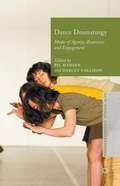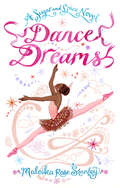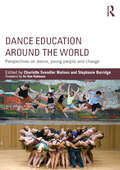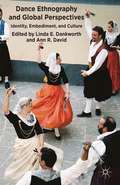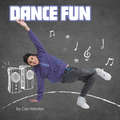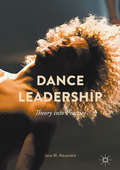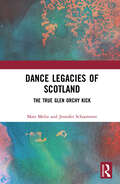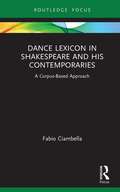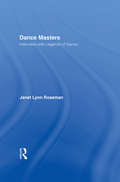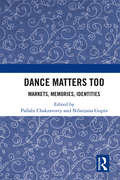- Table View
- List View
Damsels and Divas: European Stardom in Silent Hollywood
by Agata FrymusDamsels and Divas investigates the meanings of Europeanness in Hollywood during the 1920s by charting professional trajectories of three movie stars: Pola Negri, Vilma Bánky and Jetta Goudal. It combines the investigation of American fan magazines with the analysis of studio documents, and the examination of the narratives of their films, to develop a thorough understanding of the ways in which Negri, Bánky and Goudal were understood within the realm of their contemporary American culture. This discussion places their star personae in the context of whiteness, femininity and Americanization. Every age has its heroines, and they reveal a lot about prevailing attitudes towards women in their respective eras. In the United States, where the stories of rags-to-riches were especially potent, stars could offer models of successful cultural integration.
Dan Duryea: Heel with a Heart (Hollywood Legends Series)
by Mike PerosDan Duryea (1907–1968) made a vivid impression on moviegoers with his first major screen appearance as the conniving Leo Hubbard in 1941's classic melodrama The Little Foxes. His subsequent film and television career would span from 1941 until his death. Duryea remains best known for the nasty, scheming villains he portrayed in such noir masterpieces as Scarlet Street, Criss Cross, and The Woman in the Window. In each of these, he wielded a blend of menace, sleaze, confidence, and surface charm. This winning combination led him to stardom and garnered him the adoration of female fans, even though Duryea's onscreen brutality so often targeted female characters. Yet this biography's close examination of Duryea's oeuvre finds him excelling in various roles in many genres—war films, westerns, crime dramas, and even the occasional comedy. Dan Duryea: Heel with a Heart is a full-scale, comprehensive biography that examines the tension between Duryea's villainous screen image and his Samaritan personal life. At home, he proved to be one of Hollywood's most honorable and decent men. Duryea remained married to the former Helen Bryan from 1931 until her death in 1967. A dedicated family man, he and Helen took an active role in raising their children and in the community. In his career, Duryea knew villainous roles were what the public wanted—there would be a public backlash if fans read an article depicting what a decent guy he was. Frustrated that he couldn't completely shake his screen image and public persona, he wrestled with this restriction throughout his career. Producers and the public did not care to follow any new directions he hoped to pursue. This book, written with Duryea's surviving son Richard's cooperation, fully explores the life and legacy of a Hollywood icon ready for rediscovery.
Dan Graham: Rock My Religion (One Work)
by Kodwo EshunAn illustrated exploration of a groundbreaking work and its connections to New York's art and music scenes of the 1980s.Dan Graham's Rock My Religion (1982–1984) is a video essay populated by punk and rock performers (Patti Smith, Jim Morrison, Jerry Lee Lewis, and Eddie Cochran) and historical figures (including Ann Lee, founder of the Shakers). It represented a coming together of narrative voice-overs, singing and shouting voices, and jarring sounds and overlaid texts that proposed a historical genealogy of rock music and an ambitious thesis about the origins of North America's popular culture. Because of its passionate embrace of underground music, its low-fi aesthetics, interest in politics, and liberal approach to historiography, the video has become a landmark work in the history of contemporary moving image and art; but it has remained, possibly for the same reasons, one of Graham's least written about works—underappreciated and possibly misunderstood by the critics who otherwise celebrate him. This illustrated study of Graham's groundbreaking work fills that critical gap.Kodwo Eshun examines Rock My Religion not only in terms of contemporary art and Graham's wider body of work but also as part of the broader culture of the time. He explores the relationship between Graham and New York's underground music scene of the 1980s, connecting the artistic methods of the No Wave bands—especially their group dynamics and relationship to the audience—and Rock My Religion's treatment of working class identity and culture.
Dance Anatomy (Anatomy Ser.)
by Jacqui Greene HaasDance Anatomy is a visually stunning presentation of more than 100 of the most effective dance, movement, and performance exercises, each designed to promote correct alignment, improved placement, proper breathing, and prevention of common injuries.
Dance Appreciation
by Amanda Clark Sara PecinaDance Appreciation is an exciting exploration of how to understand and think about dance in all of its various contexts. This book unfolds a brief history of dance with engaging insight into the social, cultural, aesthetic, and kinetic aspects of various forms of dance. Dedicated chapters cover ballet, modern, tap, jazz, and hip-hop dance, complete with summaries, charts, timelines, discussion questions, movement prompts, and an online companion website all designed to foster awareness of and appreciation for dance in a variety of contexts. This wealth of resources helps to uncover the fascinating history that makes this art form so diverse and entertaining, and to answer the questions of why we dance and how we dance. Written for the novice dancer as well as the more experienced dance student, Dance Appreciation enables readers to learn and think critically about dance as a form of entertainment and art.
Dance Circles
by Helene Neveu KringelbachSenegal has played a central role in contemporary dance due to its rich performing traditions, as well as strong state patronage of the arts, first under French colonialism and later in the postcolonial era. In the 1980s, when the Senegalese economy was in decline and state fundingwithdrawn, European agencies used the performing arts as a tool in diplomacy. This had a profound impact on choreographic production and arts markets throughout Africa. In Senegal, choreographic performers have taken to contemporary dance, while continuing to engage with neo-traditional performance, regional genres like the sabar, and the popular dances they grew up with. A historically informed ethnography of creativity, agency, and the fashioning of selves through the different life stages in urban Senegal, this book explores the significance of this multiple engagement with dance in a context of economic uncertainty and rising concerns over morality in the public space.
Dance Class 3-In-1 Vol. 2: "A Funny Thing Happened On The Way To Paris…," "To Russia, With Love," And "A Merry 'Olde Christmas" (Dance Class Graphic Novels #2)
by BekaThree complete adventures filled with action, romance, humor, and plenty of dance numbers. Julie, Lucie, and Alia are best friends and share the same passion: dance! Practicing nonstop, they&’re training hard to get into the Nationals. These three will have to balance competition, relationships, classes, and practice without letting things get out of hand. Complicating matters is their fellow student Carla, who would do just about anything to steal the spotlight – if Julie, Lucie, and Alia let her, that is. Join the young dancers as they dance across the globe, from Russia to London, in three thrilling adventures: &“A Funny Thing Happened on the Way to Paris…,&” &“To Russia, With Love,&” and &“A Merry Olde Christmas&”!
Dance Class Vol. 5: To Russia, With Love (Dance Class Graphic Novels #5)
by BekaWhen Julie, Lucy, and Alia sign up for rock the new style brings a lot of new lessons, not the least of which is that cute boys don't necessarily make good dance partners. And the girls can't forget their ballet skills, not when Miss Anne has the whole troupe performing The Nutcracker . . . in Russia! Carla, jealous as always, is intent on ruining the show; the girls may need some help from an unexpected place to pull it off this time!
Dance Class Vol. 7: School Night Fever (Dance Class Graphic Novels #7)
by BekaThe national competition is coming up fast, and Julie, Lucie, and Alia will need all their skills, all their poise, and a lot of grit and determination to get their routine in perfect shape.The always jealous, ever-scheming Carla is trying to sabotage everything again, but the girls are used to that; what they weren't expecting was their teacher, Mary, falling sick at the worst possible moment! As they struggle to choreograph something on their own for the first time, it may be up to Lucie to step up and save the day.
Dance Class Vol. 8: Snow White and the Seven Dwarves (Dance Class Graphic Novels #8)
by BekaMary must decide how to cast the roles for the ballet Snow White, which the school will perform for International Dance Day. Bruno has no competition for the role of Prince Charming. But who will play Snow White? Julie is fed up with her perpetual image as the sweet heroine, while Carla can totally picture herself in this starring role. So who, in the end, will bite the red apple and be kissed by Bruno? Julie? Carla? Lucie? Alia? In the world of dance, anything can happen!
Dance Code: Dance Steps As A Code
by Anna UrsynMany people relax when coding is introduced as a language, rather than math. Even if someone creates alone, the technology involved in the process has already been developed by somebody else. Even one person's business requires professional input from others, and collaborations are often performed online. This book mixes experiences in art, coding, music, dance, choreography, video, and stage design. Dances have unique structures and so do computer codes. In both disciplines, steps are applied following patterns, and are guided by rules and restrictions. The rules obey conditions. The Dance Code script aims to make coding less feared by readers when talking with coders on the job and typing better prompts when using artificial intelligence. In this book, a dramatized, choreographed story unfolds technical information about coding and dancing.The Dance Code script tells the story of an online interaction between a coder and a prima ballerina, resulting in a shared understanding of their respective fields. An exchange between a coder and a dancer may inspire new ways to look at visually presenting knowledge through dancing, performing, or choreographed movement. Hence, the audience learns without studying.It is a part of the “Knowledge Through the Arts” series, consisting of:Dance Code - Dance Steps as a CodeNew Storytelling - Learning Through MetaphorsCode Appreciation - Reshaping KnowledgeNature Appreciation - Knowledge as Art
Dance Composition: A Practical Guide to Creative Success in Dance Making (Ballet, Dance, Opera And Music Ser. #3)
by Jacqueline M. Smith-AutardFirst Published in 2005. Routledge is an imprint of Taylor & Francis, an informa company.
Dance Data, Cognition, and Multimodal Communication (Routledge Advances in Theatre & Performance Studies)
by Carla Fernandes Vito Evola Cláudia RibeiroDance Data, Cognition, and Multimodal Communication is the result of a collaborative and transdisciplinary effort towards a first definition of "dance data", with its complexities and contradictions, in a time where cognitive science is growing in parallel to the need of a renewed awareness of the body’s agency in our manyfold interactions with the world. It is a reflection on the observation of bodily movements in artistic settings, and one that views human social interactions, multimodal communication, and cognitive processes through a different lens—that of the close collaboration between performing artists, designers, and scholars. This collection focuses simultaneously on methods and technologies for creating, documenting, or representing dance data. The editors highlight works focusing on the dancers’ embodied minds, including research using neural, cognitive, behavioural, and linguistic data in the context of dance composition processes. Each chapter deals with dance data from an interdisciplinary perspective, presenting theoretical and methodological discussions emerging from empirical studies, as well as more experimental ones. The book, which includes digital Support Material on the volume's Routledge website, will be of great interest to students and scholars in contemporary dance, neuro-cognitive science, intangible cultural heritage, performing arts, cognitive linguistics, embodiment, design, new media, and creativity studies.
Dance Discourses: Keywords in Dance Research
by Susanne Franco Marina NorderaFocusing on politics, gender, and identities, a group of international dance scholars provide a broad overview of new methodological approaches – with specific case studies – and how they can be applied to the study of ballet and modern dance. With an introduction exploring the history of dance studies and the development of central themes and areas of concerns in the field, the book is then divided into three parts: politics explores 'Ausdruckstanz' – an expressive dance tradition first formulated in the 1920s by dancer Mary Wigman and carried forward in the work of Pina Bausch and others gender examines eighteenth century theatrical dance – a time when elaborate sets, costumes, and plots examined racial and sexual stereotypes identity is concerned with modern dance. Exploring contemporary analytical approaches to understanding performance traditions, Dance Discourses' pedagogical structure makes it ideal for courses in performing arts and humanities.
Dance Dramaturgy: Modes Of Agency, Awareness And Engagement (New World Choreographies)
by Pil Hansen Darcey CallisonTen international dramaturg-scholars advance proposals that reset notions of agency in contemporary dance creation. Dramaturgy becomes driven by artistic inquiry, distributed among collaborating artists, embedded in improvisation tasks, or weaved through audience engagement, and the dramaturg becomes a facilitator of dramaturgical awareness.
Dance Dreams
by Malaika Rose StanleyWhen she receives a call-back from the amazing Birchwood School for Dance, thirteen-year-old Keisha is over the moon. She’s one pirouette closer to becoming a superstar ballerina!But getting a place at Birchwood would mean moving schools and leaving behind her BFFs – and the swoon-worthy Joel Daley-Clarke. Until she knows the outcome, Keisha must keep the biggest news of her life a secret from her best friends.Can she hold it together, or will her dance dreams turn into a nightmare?
Dance Education around the World: Perspectives on dance, young people and change
by Charlotte Svendler Nielsen Stephanie BurridgeDance has the power to change the lives of young people. It is a force in shaping identity, affirming culture and exploring heritage in an increasingly borderless world. Creative and empowering pedagogies are driving curriculum development worldwide where the movement of peoples and cultures generates new challenges and possibilities for dance education in multiple contexts. In Dance Education around the World: Perspectives on Dance, Young People and Change, writers across the globe come together to reflect, comment on and share their expertise and experiences. The settings are drawn from a spectrum of countries with contributions from Europe, the Americas, the Middle East, Asia, the Pacific and Africa giving insights and fresh perspectives into contrasting ideas, philosophies and approaches to dance education from Egypt to Ghana, Brazil to Finland, Jamaica to the Netherlands, the UK, USA, Australia, New Zealand and more. This volume offers chapters and narratives on: Curriculum developments worldwide Empowering communities through dance Embodiment and creativity in dance teaching Exploring and assessing learning in dance as artistic practice Imagined futures for dance education Reflection, evaluation, analysis and documentation are key to the evolving ecology of dance education and research involving individuals, communities and nations. Dance Education around the World: Perspectives on Dance, Young People and Change provides a great resource for dance educators, practitioners and researchers, and pushes for the furtherance of dance education around the world. Charlotte Svendler Nielsen is Assistant professor and head of educational studies at the Department of Nutrition, Exercise and Sports, research group Body, Learning and Identity, University of Copenhagen, Denmark. Stephanie Burridge lectures at Lasalle College of the Arts and Singapore Management University, and is the series editor for Routledge Celebrating Dance in Asia and the Pacific.
Dance Ethnography and Global Perspectives
by Linda E. Dankworth Ann R. DavidDance Ethnography and Global Perspectives presents the work of dance scholars whose professional fieldwork spans several continents and includes studies of the dance and movement systems of varied global communities. It offers a selection of dance ethnographies that represent individual approaches to fieldwork through the medium of traditional dance from around the globe Bali, Croatia, Japan, Mallorca, Okinawa, the Philippines, Serbia, the United Kingdom, and West Africa. This fascinating collection is divided into three parts that represent different theoretical approaches to the study of dance and identity through the methodology of ethnography. With backgrounds in a wide range of disciplines, such as religious studies, social and cultural anthropology, folklore, history, psychosocial work, and tourism, the authors include various media of film and photographs to enrich their methodologies. "
Dance Fun (Sports Fun)
by Cari MeisterDance is fun to watch, but it’s even more fun to do! Kids can take the stage by learning what dance is, what gear and skills are needed, what happens during lessons, and how to be a good sport. A special activity helps kids build a basic dance skill.
Dance History: An Introduction
by Janet Adshead-Lansdale June LaysonOriginally published in 1983 the first edition rapidly established itself as a core student text. Now fully revised and up-dated it remains the only book to address the rationale, process, techniques and methodologies specific to the study of dance history. For the main body of the text which covers historical studies of dance in its traditional and performance contexts, the editors have brought together a team of internationally known dance historians. Roger Copeland and Deborah Jowitt each take a controversial look at the modern American dance. Kenneth Archer and Millicent Hodson explain the processes they use when reconstructing 'lost' ballets, and Theresa Buckland and Georgina Gore write on traditional dance in England and West Africa respectively. With other contributions on social dance, ballet, early European modern dance and feminist perspectives on dance history this book offers a multitude of starting points for studying dance history as well as presenting examples of dance writing at its very best. Dance History will be an essential purchase for all students of dance.
Dance Leadership: Theory Into Practice
by Jane M. AlexandreThis "what is"--rather than "how to"-- volume proposes a theoretical framework for understanding dance leadership for dancers, leaders, and students of both domains, illustrated by portraits of leaders in action in India, South Africa, UK, US, Brazil and Canada. What is dance leadership? Who practices it, in what setting, and why? Through performance, choreography, teaching, writing, organizing and directing, the dance leaders portrayed herein instigate change and forward movement. Illustrating all that is unique about leading in dance, and by extension the other arts, readers can engage with such wide-ranging issues as: Does the practice of leading require followers? How does one individual's dance movement act on others in a group? What does 'social engagement' mean for artists? Is the pursuit of art and culture a human right?
Dance Legacies of Scotland: The True Glen Orchy Kick
by Mats Melin Jennifer SchoonoverDance Legacies of Scotland compiles a collage of references portraying percussive Scottish dancing and explains what influenced a wide disappearance of hard-shoe steps from contemporary Scottish practices. Mats Melin and Jennifer Schoonover explore the historical references describing percussive dancing to illustrate how widespread the practice was, giving some glimpses of what it looked and sounded like. The authors also explain what influenced a wide disappearance of hard-shoe steps from Scottish dancing practices. Their research draws together fieldwork, references from historical sources in English, Scots, and Scottish Gaelic, and insights drawn from the authors’ practical knowledge of dances. They portray the complex network of dance dialects that existed in parallel across Scotland, and share how remnants of this vibrant tradition have endured in Scotland and the Scottish diaspora to the present day. This book will be of interest to scholars and students of Dance and Music and its relationship to the history and culture of Scotland.
Dance Lexicon in Shakespeare and His Contemporaries: A Corpus Based Approach (Studies in Performance and Early Modern Drama)
by Fabio CiambellaThis book provides a thorough analysis of terpsichorean lexis in Renaissance drama. Besides considering not only the Shakespearean canon but also the Bard’s contemporaries (e.g., dramatists as John Marston and Ben Jonson among the most refined Renaissance dance aficionados), the originality of this volume is highlighted in both its methodology and structure. As far as methods of analysis are concerned, corpora such as the VEP Early Modern Drama collection and EEBO, and corpus analysis tools such as #LancsBox are used in order to offer the widest range of examples possible from early modern plays and provide co-textual references for each dance. Examples from Renaissance playwrights are fundamental for the analysis of connotative meanings of the dances listed and their performative, poetic and metaphoric role in sixteenth- and seventeenth-century drama. This study will be of great interest to Renaissance researchers, lexicographers and dance historians.
Dance Masters: Interviews with Legends of Dance
by Janet Lynn RosemanDance Masters is a lively ensemble of conversations with seven celebrated dancers and choreographers. In these intimate interviews, dance critic Janet Lynn Roseman probes the heart of dance: * The creative process * The role of dream and rituals * The interplay between dancer and audience * The spiritual aspects of performance These dance masters offer rare insights into the internal world of the artist as they reveal their philosophies on dance training, discuss their mentors, and speak candidly about the artistic process of dance-making and how it actually feels to dance.
Dance Matters Too: Markets, Memories, Identities
by Pallabi Chakravorty Nilanjana GuptaDance Matters Too: Markets, Memories, Identities is a rich intellectual contribution to the growing field of dance studies in India. It forges new avenues of scholarly inquiry and critical engagement and opens the field in innovative ways. This volume builds on Dance Matters (2009), which mapped the interdisciplinary breadth of the field. The chapters presented here continue to underline the uniqueness of a field that is a blend of critical scholarship on aesthetics and performance with the humanities and social sciences. Including diverse material, analytical approaches and perspectives from scholars and practitioners, this multidimensional volume explores debates on dance preservation and tradition in globalizing India, multimedia choreographies and the circulation of dance via electronic media, embodiment and memory, power, democracy and bourgeoning markets, classification and censorship, and corporatization and Bollywood. This tour de force will appeal to those in dance and performance studies, cultural studies, sociology as well as to readers interested in tradition, modernity, gender and globalization.
